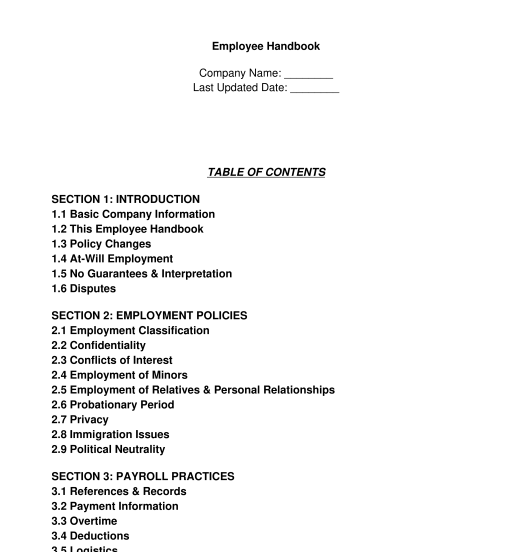 09/11/2025
09/11/2025

Answer a few questions and your document is created automatically.

Your document is ready! You will receive it in Word and PDF formats. You will be able to modify it.




Rating: 4.8 - 581 votes
Download a basic template (FREE) Create a customized documentAn employee handbook is a detailed document used by an employer to outline the rules, practices, and procedures for the employees at the company. The handbook is used to inform employees about the standards that are expected of them. Employee handbooks are often very long, very robust documents. Despite that, however, most employee handbooks are not meant to be absolutely comprehensive guides on everything surrounding the employment relationship. Rather, they are baselines for company policies, through which employees can also find out how to access any additional information they may need.
Though both documents are used by an employer, they are created differently and have different purposes. An employee handbook contains the rules and standards that apply to all employees in the workplace. Employees do not negotiate anything contained in the handbook. Employers are the ones who unilaterally make the policies that employees will follow.
An employment agreement is a specific contract used for just one individual and the company. The employee is involved in negotiating its terms, and it dictates the employment relationship between that employee and the employer. It includes specific details such as salary, benefits, and the scope of the position that the employee is entering into.
No, it is not mandatory to have an employee handbook. Some employers, especially those with very few employees, may choose to have policies conveyed to employees through word of mouth. However, an employee handbook is a good idea for almost all employers, since it clearly lays out policies in writing and assures that everyone is on the same page about their rights and responsibilities in the workplace.
A non-disclosure agreement is a contract that means the employees must keep certain elements of their employment secret, such as trade secrets or confidential information. Employers may have a policy requiring that all employees sign a non-disclosure agreement as a condition of their employment.
A flexible spending account (FSA) is a special account that employees can use to put money into for out-of-pocket healthcare costs. The money is put into the account before taxes are taken out, so it saves employees money and helps them shoulder their healthcare costs.
A 401K is a special pre-tax investing and savings plan. A certain amount of money is automatically deducted from the employee's paycheck that they are permitted to save with deferred tax responsibilities. These types of accounts are typically used for retirement savings.
Though an employee handbook provides regulations for employees, it is created only by the employer. If the employer has a human resources department, the head of that department is usually the one responsible for creating the handbook to reflect the preferences of the company management. Individual employees are typically not involved in the creation of the handbook and the policies it contains.
When this agreement is filled out, it should be printed out and kept on file with the company. Then, each time an employee starts work with the company, the employee should be given a copy of the handbook and asked to sign the acknowledgment page. The company should keep a copy of the signed acknowledgment page, and the employee should keep the complete handbook.
If the handbook has already written any policies or regulations that they would like to incorporate into the handbook, they may attach them to the handbook as an addendum. Going forward, if the employer creates new policies, they may also attach these to the handbook.
The employer should regularly review the employee handbook to be sure that all of its rules, regulations, and policies are up-to-date and accurately reflect the current wishes of the employer. If the employer would like to add any new provisions to the handbook, they may write them separately and then include them as an attachment to the book. If the employer would like to change or remove provisions that are currently in the handbook, they should update the text of the book itself, reprint it, and distribute it to employees as needed.
Although the employer creates the employee handbook, the employer themselves are not bound to its terms and can change them at any time according to their discretion. The employee handbook is not a promise or contract of employment, but a tool to help employees learn about the rules and expectations around their employment with the employer.
A valid employee handbook must contain at least the following mandatory clauses:
In addition to the above required information, the following information may also be included:
The policies contained within employee handbooks are subject to federal, state, and local laws and regulations. The primary purpose of these laws is to ensure that employer policies are fair, non-discriminatory, and comply with required standards. Federally, the main law that applies to employee policies is the Fair Labor Standards Act (FLSA). This law controls things such as overtime pay, record keeping, and minimum wage requirements. Additionally, the Occupational Safety and Health Act (OSHA) controls employee safety in the workplace. On a state level, all states have laws that require employers to abide my state wage and hour laws. States also have individual anti-discrimination laws that apply to employment. Finally, states often require that employers offer a minimum amount of family and medical leave to employees.
You fill out a form. The document is created before your eyes as you respond to the questions.
At the end, you receive it in Word and PDF formats. You can modify it and reuse it.
A guide to help you: Important Considerations for your Employment Agreement
Employee Handbook - FREE - Template - Word & PDF
Country: United States